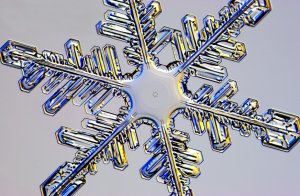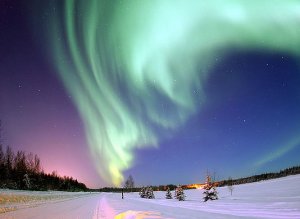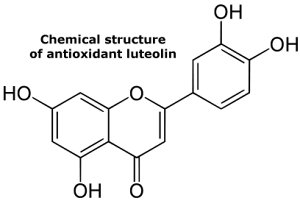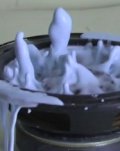Graphene is perhaps the thinnest material known. Essentially it is a single, isolated layer of the carbon allotrope graphite. In SpectroscopyNOW this week I discuss new research into how a single layer of graphene is transparent to water molecules in the sense that the water can “see” whatever is underneath without the graphene influence. More details on that and potential applications over on SN, but it was the coincidence of a paper by Geim and colleagues at Manchester, which I covered last week in Chemistry World that intrigued me. On the one hand water interacts with a metal coated with a single layer of graphene as if the graphene were not there, yet multiple layers of graphene oxide are impermeable to helium atoms but will let water pour through.
I asked the author of the single-layer work, Nikhil Koratkar of Rensselaer Polytechnic Institute in Troy, New York to compare and contrast his discovery with the Geim work:
“They appear to be working with a film which could be microns thick,” he told me. “The film is comprised of graphene oxide sheets that have aggregated to form a film. Now graphene oxide is very different from graphene. It is strongly hydrophilic and water spreads completely on graphene oxide. Given the fact that the film is an aggregate of graphene oxide sheets it will have a porous structure and hence it is not that surprising that water seeps through these pores. What is very interesting is that helium does not get through! Which means that the pores in the film are very small. Inspite of that water is able to force its way through these pores which is indeed interesting. In our system we have a single graphene (not graphene oxide) sheet and no pores. So there is no question of the water passing through the graphene.”
 On Christmas Day 2006, I posted a blog about how snowflakes are not all different and some of the science underlying the formation of snowflakes. The American Chemical Society had a nice infographic at the time showing the principles of snowflake formation (PDF here). There’s no snow around here, but this is Britain, the weather could change at any moment and although we don’t quite have the four seasons in one day they get in New Zealand, give it a day or two and a warm spell can become a cold snap almost overnight.
On Christmas Day 2006, I posted a blog about how snowflakes are not all different and some of the science underlying the formation of snowflakes. The American Chemical Society had a nice infographic at the time showing the principles of snowflake formation (PDF here). There’s no snow around here, but this is Britain, the weather could change at any moment and although we don’t quite have the four seasons in one day they get in New Zealand, give it a day or two and a warm spell can become a cold snap almost overnight. I’ve not yet seen the Aurora borealis, nor the Aurora australis, but they’re always on my mind. I am sure they’re amaaazing and wunderfuuul. This week a coronal mass ejection (CME) from the Sun stimulated the earth’s atmosphere and magnetic field to produce some marvellous lights that were even seen as far south as Northern England. There are plenty of photos on the web now and video footage is growing. Amateur astronomers have been gripped by the aurorae, apparently as have amateur astrologers looking for aura…
I’ve not yet seen the Aurora borealis, nor the Aurora australis, but they’re always on my mind. I am sure they’re amaaazing and wunderfuuul. This week a coronal mass ejection (CME) from the Sun stimulated the earth’s atmosphere and magnetic field to produce some marvellous lights that were even seen as far south as Northern England. There are plenty of photos on the web now and video footage is growing. Amateur astronomers have been gripped by the aurorae, apparently as have amateur astrologers looking for aura… A flavonoid compound found in fruit and vegetables, luteolin, was recently hailed as an anticancer supernutrient by the tabloid media. Aside from the fact that over-dosing on antioxidants could be detrimental to one’s front-line immune response to pathogens, the research was purely laboratory based and said nothing about whether or not luteolin might actually prevent bowel cancer. The compound has the chemical name 2-(3,4-dihydroxyphenyl)- 5,7-dihydroxy-4-chromenone and in the laboratory shows activity as an inhibitor of phosphodiesterase enzymes as well as blocking interleukin 6.
A flavonoid compound found in fruit and vegetables, luteolin, was recently hailed as an anticancer supernutrient by the tabloid media. Aside from the fact that over-dosing on antioxidants could be detrimental to one’s front-line immune response to pathogens, the research was purely laboratory based and said nothing about whether or not luteolin might actually prevent bowel cancer. The compound has the chemical name 2-(3,4-dihydroxyphenyl)- 5,7-dihydroxy-4-chromenone and in the laboratory shows activity as an inhibitor of phosphodiesterase enzymes as well as blocking interleukin 6. Sometimes an old viral video needs another airing. In this video from about three years ago, a mixture of corn starch poured into a speaker cone is vibrated at 30 Hz using a signal generator and the video shot at 30 frames per second (coincident timing with the speaker frequency).
Sometimes an old viral video needs another airing. In this video from about three years ago, a mixture of corn starch poured into a speaker cone is vibrated at 30 Hz using a signal generator and the video shot at 30 frames per second (coincident timing with the speaker frequency).